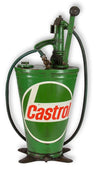1. WASH / POLISH / CLEAN: Winter is the ideal time to show some love to your classic, and give it a refreshing spring clean.
- Ensure the exterior is immaculately cleaned using car shampoo to get rid of all dirt and grime, and don't forget to apply wax polish to the bodywork and chrome. This will prevent bird droppings, tree resin and other substances from causing damage to the paint.
- The interior also needs attention - cleaning and vacuuming will make it spotless and ready for use when the weather gets warmer.
- Place baking soda refrigerator packages in the interior and trunk areas. I also like to add scented dryer sheets - the rodents hate it !!
- If the vehicle will be exposed to freezing temperatures, be certain no personal items that may freeze or burst are left in the vehicle.
2. COOLANT: The engine coolant not only serves the purpose of safeguarding against freezing but also acts as an anti-corrosive agent. However, with the passage of time, the anti-corrosive properties of the coolant tend to decrease. Therefore, it is recommended to periodically check and replenish the anti-freeze or alternatively, drain and refill the entire system if deemed necessary.
3. FUEL TANK: Unprotected metal that is exposed to air is susceptible to corrosion, and fuel tanks are not exempt from this. To prevent corrosion, it is advisable to fill the tank with fuel, minimizing or eliminating air circulation. Additionally, for extended periods of storage, it is wise to incorporate a fuel preservative.
4. OIL CHANGE: Over the course of a driving season, engine oil accumulates a variety of dirt and chemicals that can lead to corrosion in the engine. Whilst it is commonly known that changing the oil on a regular basis is crucial, doing so at the end of the season, rather than at the start, can prevent damage from occurring during the winter months. This preventive measure ensures that your engine stays in optimal condition.
5. TIRES: If you leave your car stationary for extended periods, the tires can develop flat spots from being in contact with the floor. To prevent this, you can elevate the vehicle on stands, use tire trainers to distribute the weight over a larger area of the tire, or inflate to their maximum pressure as indicated on the sidewall. These solutions will help mitigate the potential for flat spotting.
6. WIPERS: Leaving your wipers stationary for extended periods can result in them becoming fused with the windscreen. To prevent this, it is essential to either lift them away from the glass or place a layer of newspaper beneath them.
7. BATTERY: Removing the battery and storing it indoors or using a battery conditioner to maintain its charge can be a practical measure to prevent it from losing its power. This ensures that when spring arrives, it will be fully charged and ready power your little beauty without any hindrances.
8. LOCATION, LOCATION, LOCATION: Select a dry, dark location for storage — preferably with limited access. Concrete flooring is best at keeping away moisture. If you must store your car on a dirt floor, place a plastic barrier under the vehicle, and place carpet pieces or plywood under the tires.
9. TO START, OR NOT TO START PERIODICALLY?: There are varying theories about periodically starting the vehicle. This writer feels unless you get the engine up to operating temperature for a good 10-plus minutes to burn off the water vapors that initially develop at startup-cold operation, starting is not a good idea. Anything less will leave water in the combustion chamber and all exhaust components.







